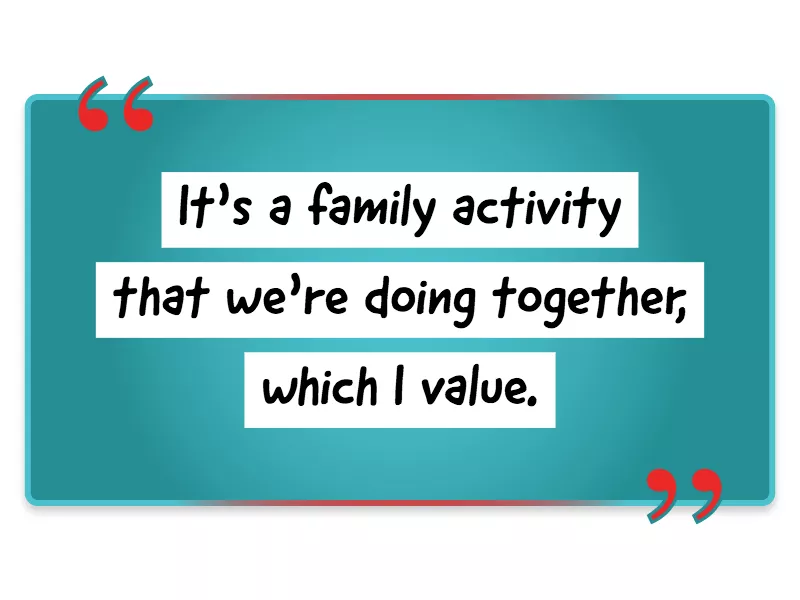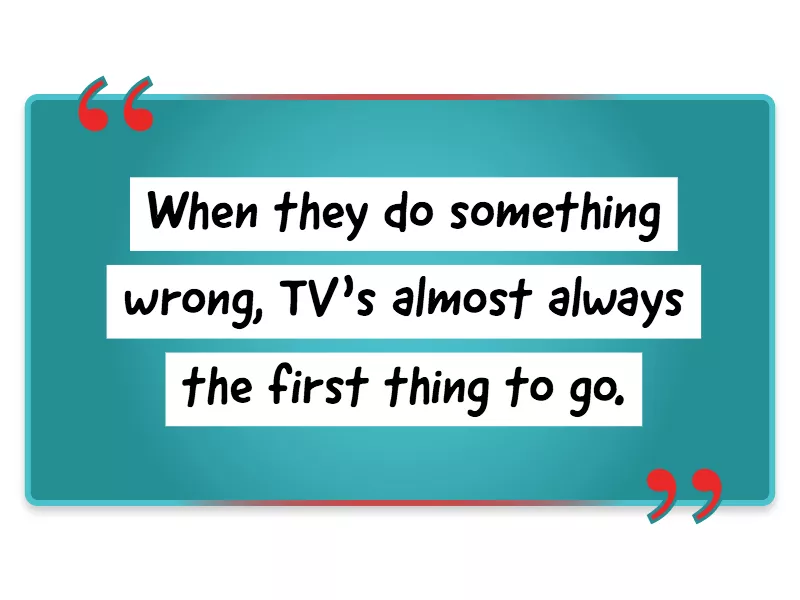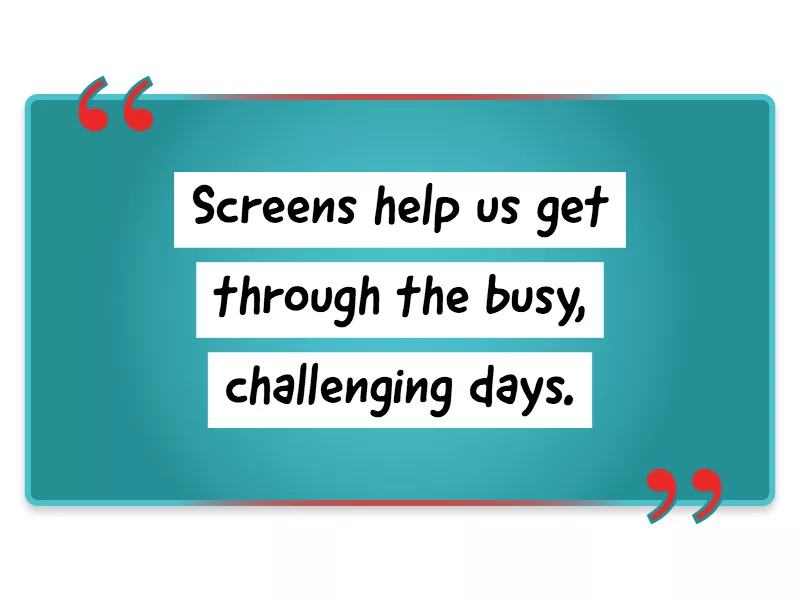Before I had kids, I made a lot of promises to myself about what kind of parent I would be. I wouldn’t use baby talk, I wouldn’t yell, I wouldn’t let my kids eat off of plastic plates, and I most certainly wouldn’t let them watch TV on my iPhone while we were out to dinner. Ha!
As it turns out, judging real parents that you’ve seen doing things “you would never do” is much, much easier than being an actual parent. But since having kids of my own, I can proudly say that I’ve broken all of these promises to myself. And you know why? Because they aren’t realistic.
In my experience, one of the most-judged and -debated parenting topics is screen time. While disapproving looks from fellow parents who see my kids holding my phone are hard to ignore, I don’t care about them. That’s because I don’t believe forcing myself to have a no-screen-time rule for my kids is effective — and here’s why.
How Much Is Too Much?

When debating screen time, the ultimate question is inevitably: How much is too much? When people give me judgmental looks in a restaurant, I used to offer up a justification as to why I was allowing it to happen, “They didn’t nap today and we are waiting for the check.” Or I would shift the focus to my kids and say out loud, “Just five more minutes, okay?”
I think I was trying to prove to strangers that I was a good mom. But then I realized that those people have no idea how much time my kids do, or don’t, spend looking at a screen. Yes, there’s such a thing as too much screen time, but I created my own set of guidelines based on expert research and, honestly, what simply makes sense for me and my family.
Want to help kids reduce screen time and develop their imagination and creativity? Download Animopus from the App Store. Animopus is a drawing app for kids (ages 2 and up) that turns cartoon consumers into cartoon creators.
Consider the Age

The American Academy of Pediatrics (AAP) recommends that children younger than 18 months avoid screen media, with the exception of video chatting. For children ages two to five years, AAP says to limit screen use to one hour per day. For children ages six and older, AAP recommends placing consistent limits on media time and tells parents to “make sure media does not take the place of adequate sleep, physical activity and other behaviors essential to health.”
In an ideal world, all of that seems fair and reasonable. These guidelines are something to aim for, but don’t beat yourself up if one day your three-year-old watches a total of two hours of TV instead of one hour.
Consider the Place

Putting screen-time limits on my kids based on where we are or what we’re doing has helped a ton. If we’re at a park or at a baseball game, I don’t allow them to look at a screen. Same goes if we’re doing anything that’s geared towards them. If we’re at the store getting art supplies for their class, I don’t let them sit in the cart and play games on my phone.
On the other hand, if we’re at the grocery store for an hour shopping for Thanksgiving supplies, and they get bored, I might let them spend time on my phone. Or, if I’ve dragged them to a friend’s house who doesn’t have kids and they have exhausted their entertainment options, I allow them to use my phone or watch TV if they ask. Setting my own personal rules about location has helped me stick to my guns.
Consider the Circumstance

A new thing that’s entered our house is family movie nights. My kids are finally old enough to sit still and actually watch whole movies. What that means, though, is that nearly two hours is added to our kids’ TV time that day. That doesn’t bother me for a couple of reasons.
First of all, we don’t do it every night. Secondly, it’s a family activity that we’re doing together, which I value. Third, my kids are quiet and relaxed. Of course, we do other things together, like game nights, so in these types of circumstances, I let myself break my own rules.
Being Confident in Said Rules

Speaking of rules, I have them because they keep me sane. They also give me a sense of confidence if I’m in a situation in which someone disagrees with my decision. If I’m talking to a friend or even a stranger and I tell them that my kids watch TV every morning when they wake up, they may throw a little judgment my way.
I find that I’m more equipped to be OK with that judgment because I know that I have rules in place. For us, TV is allowed in the morning, but only for up to 45 minutes. My kids rarely watch TV that long and, as their mom, that’s something only I know.
YouTube Versus Educational Shows

When my oldest son was two, he discovered YouTube. We were at a party with friends, and their son was watching YouTube Kids on a smartphone. My son sat next to him on the couch, and they both watched a video of a little boy opening boxes of toys and playing with them for nearly 15 minutes. I remember being in awe of the whole thing. My kid hadn’t sat still that long in his life.
That was the beginning of the end for our son. He was obsessed. Every morning he’d wake up and point to our TV and say “YouToo.” For a while, I let it happen. He woke up early, and it allowed me personal time to make coffee and do my own thing. Months later, we were at his three-year-old checkup, and he was being extremely impatient waiting for the doctor to come in the room. He kept trying to grab my phone out of my purse, and I kept closing it and telling him he couldn’t use it.
He had a complete meltdown and I gave in. When his pediatrician came in, he was happily watching YouTube on my phone in his little gown. Everything seemed fine, until the end of the appointment when his doctor turned to me and said, “You don’t let him watch that for more than an hour a day, do you? We want him to be an engineer and build with blocks, not just watch TV.”
I was mortified.
The next day, I cut him off cold turkey. There were a lot of tears, but it had gotten out of hand, and I needed to take control. My husband and I decided that TV was okay — educational programming like PBS or Sesame Street that teaches a lesson — but YouTube had to go. Now that my son is older, we’ve allowed it back into the house again, but it has a very strict time limit.
Rewarding Kids With TV

Because my kids like watching TV so much, we always make sure that they know that it’s a reward and can be taken away. When they do something wrong, it’s almost always the first thing to go. It could be a day or a week, but our kids always get the message.
If they’ve been good listeners and don’t fight with one another for a while, we may let them watch an extra show or reward them with a movie night later that week. TV has become part of our reward system, and it works wonders for our kids’ behavior.
What the Experts Say

The National Institutes of Health is currently doing an ongoing study that tests how screen time affects children’s brains. The study is following more than 11,000 children and, when it’s complete, will have data for 10 years.
According to “Insider,” the first brain scans from the study have been analyzed, and they have come to the conclusion that “children who spend more than seven hours a day on screens experience premature thinning of the cortex.” The study also found that “children who have more than two hours of screen time a day got lower scores on tests focused on thinking and language skills.”
What Parents Say

Every parent I know has different screen-time rules, but that’s because every parent I know has a different routine and lifestyle. I have friends who work in an office 40 hours a week, friends who are stay-at-home parents, friends who work in education (and therefore have summers off) and friends who work from home.
All of those things factor into your child’s screen time versus other time that you, as their parent, spend with them. One thing every parent I know agrees on, though, is that they do what works for them.
Traveling

As Californians with families all over the state, my husband and I do a lot of car travel. We drive long distances with toddlers and we’ve learned that screens are key to making that a pleasant experience. So, on those days, we break all of the rules. There aren’t time limits.
In addition to DVD players and phone games, my kids also have coloring books and toys. It’s their choice what they want to do to entertain themselves. Screens help keep everyone happy and still enjoying each other’s company after eight hours in the car together.
Survival Tool

Just like on travel days, sometimes screens are simply a survival tool in this thing called parenting. Some days I need to make dinner and my kids won’t stop whining, so I turn on Netflix.
Some days I encourage them to leave the TV off and bring out their art supplies. And some days I let them watch YouTube videos on my phone while I look at Pinterest on my computer. Screens help us get through the busy, challenging days.
Flexibility

Being flexible has changed the way I feel about my kids using technology. I wasn’t raised with as much access to TVs, computers, tablets and smartphones, so it’s hard for me to understand why kids are on them so much. I often find myself thinking about when I was young and the rules I had to follow while sitting across from my parents at restaurants. I had a piece of paper and a few crayons; that’s it.
I was expected to sit still and mind my manners. And that’s exactly what I want my kids to do, too. But I have to be flexible. These new tools are available in the parenting toolbox, so why not use them every now and again?
Finding a Balance

Like most aspects of parenting, what it all really comes down to is finding a balance that works for your family. My husband and I work from home and can easily monitor what our kids are watching and when, and we’ve put some solid rules in place that makes everyone happy. But we also know that it’s OK to break our rules every now and then.
As long as you feel good about your child’s behavior, then keep doing what you’re doing. If you’re happy with your choices and your rules, you’ll be much more equipped to handle the stranger in the mall’s question, “Isn’t that bad for her? Isn’t she too young?” when all you’re trying to do is buy a birthday present for your mom, and the Netflix app is the only thing keeping your toddler in a stroller for longer than 30 seconds.
Want to help kids reduce screen time and develop their imagination and creativity? Download Animopus from the App Store. Animopus is a drawing app for kids (ages 2 and up) that turns cartoon consumers into cartoon creators.